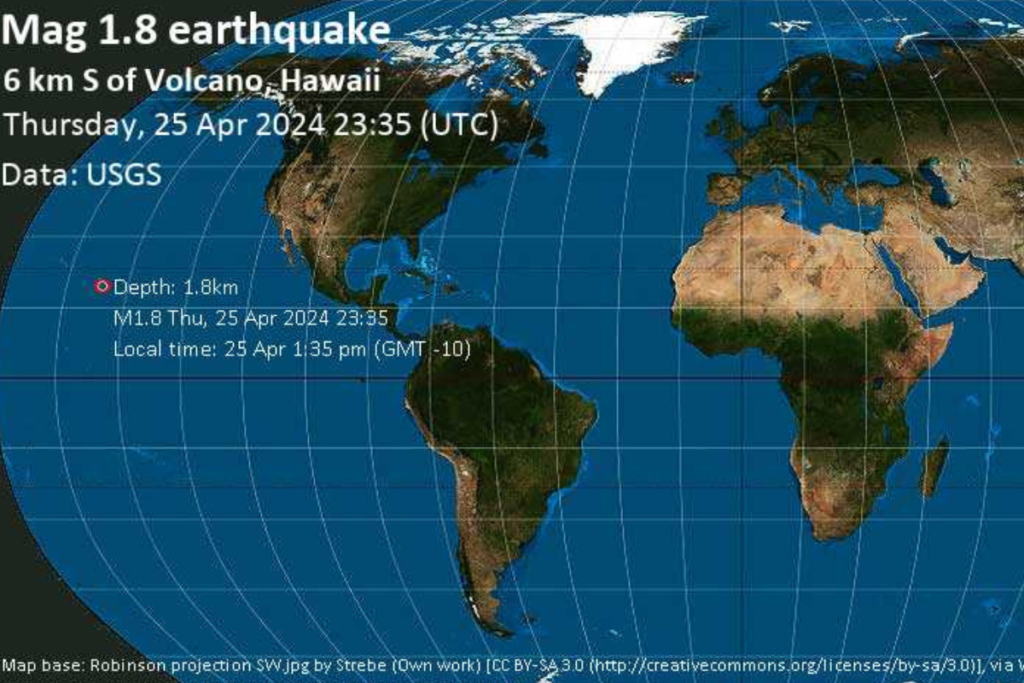Residents of Hawaii County, Hawaii, were jolted by a minor earthquake measuring 2.4 on the Richter scale.
The tremor, centered approximately 26 miles southwest of Hilo, sent ripples of concern across the island, prompting authorities to reassure the public about the event’s minimal impact.
The quake struck on Sunday, April 28, 2024, at 10:55 PM local time, causing a momentary stir among residents.

Though no significant damage has been reported, the incident serves as a reminder of the island’s geographical vulnerability to seismic activity.
Localized Impact: The Quake’s Epicenter
The epicenter of the earthquake was pinpointed southwest of Hilo, a city situated on the eastern coast of the Island of Hawaii.
This region, known for its volcanic activity and geological instability, often experiences minor tremors.
The shallow depth of the quake, occurring just beneath the earth’s surface, contributed to its perceptibility by residents in the vicinity.
Despite its relatively low magnitude, the quake’s location in a populated area heightened concerns among locals.
Response and Preparedness: Reassurance Amid Concerns
In the aftermath of the earthquake, local authorities swiftly mobilized to assess any potential damage and provide assurance to the community.
The Hawaii County Civil Defense Agency, responsible for emergency management on the island, issued statements affirming that the quake posed no immediate threat to public safety.
Residents were urged to remain calm and vigilant while authorities conducted thorough inspections of infrastructure and critical facilities.
Community Resilience: A Testament to Preparedness
The resilience of Hawaii’s communities in the face of natural events has been repeatedly demonstrated over the years.
With a culture deeply rooted in the island’s natural environment, residents have developed a keen awareness of seismic risks and adopted measures to mitigate potential impacts.
Earthquake drills, building codes designed to withstand tremors, and community preparedness initiatives are integral components of Hawaii’s disaster resilience strategy.
Seismic Activity in the Pacific: Understanding the Context
Hawaii’s location in the Pacific Ring of Fire makes it susceptible to seismic activity, including earthquakes and volcanic eruptions.
The Ring of Fire, characterized by tectonic plate boundaries and active volcanic arcs, encircles the Pacific Ocean, marking regions prone to geological phenomena.
The movement of tectonic plates beneath the Earth’s surface generates stress that can result in earthquakes, with varying magnitudes and frequencies.
Monitoring and Research: Advancing Earthquake Science
Advancements in seismology and earthquake monitoring have enhanced our understanding of seismic events, enabling more accurate predictions and early warning systems.
Networks of seismographic stations, such as the Pacific Tsunami Warning Center and the United States Geological Survey (USGS), continuously monitor seismic activity in the region.
Real-time data from these networks inform emergency response efforts and contribute to ongoing research on earthquake dynamics.
Community Engagement: Promoting Awareness and Preparedness
Education and community engagement play crucial roles in promoting earthquake awareness and preparedness.
Public outreach initiatives, including informational campaigns and educational programs, empower residents with the knowledge and resources needed to respond effectively to seismic events.
By fostering a culture of preparedness, communities can minimize the impact of earthquakes and enhance their resilience in the face of natural disasters.
Looking Ahead: Remaining Vigilant in Uncertain Times
As residents of Hawaii reflect on the recent earthquake, there is a collective recognition of the need to remain vigilant in the face of uncertain times.
While minor tremors are a familiar occurrence in the region, they serve as reminders of the dynamic forces shaping the Earth’s surface.
By continuing to invest in preparedness measures and fostering a culture of resilience, Hawaii’s communities stand ready to confront whatever challenges the future may bring.
Conclusion: A Momentary Stir, A Resilient Response
The magnitude 2.4 earthquake that rattled Hawaii County on April 28, 2024, serves as a testament to the island’s resilience in the face of natural events.
While the tremor briefly unsettled residents, it ultimately underscored the importance of preparedness and community cohesion.
As Hawaii continues to navigate its dynamic geological landscape, the lessons learned from this event will inform ongoing efforts to enhance resilience and ensure the safety and well-being of all who call the island home.